 |
| Dak Nhau commune strives to become an advanced new rural commune by 2030. Photo: Nhu Nam |
The story of the loyal love between the army and the people
The Nua Lon Base relic is currently located in village 5, Dak Nhau commune, Dong Nai province. In the years 1960-1965, this place was the starting point of the strategic corridor connecting the great rear - the socialist North with the great front - the South. From this base, tens of thousands of cadres, soldiers, and children of the South gathered in the North and returned to the battlefield, contributing to the formation of the strategic trail later named the legendary Ho Chi Minh trail.
Mr. Dieu M'Rieng, former armed security soldier of Zone 10, former head of the Propaganda Department of Bu Dang District Party Committee (formerly Binh Phuoc province), now over 70 years old, confided: Nua Lon base has now become lush cashew and rubber gardens. The passing years have erased all traces, but he still remembers clearly that the base area was a primeval forest, a transition between the vast Central Highlands and the Southeast, so it was suitable for building a revolutionary base.
Mr. Dieu M'Rieng said: In mid-1960, comrade Pham Thuan (Ba Thu) was assigned to command the armed propaganda team, clearing the way to Bom Bo hamlet to contact the Northern working group to support the Southern battlefield. After more than a month of trekking through the forest but unable to make contact, and running out of food, comrade Ba Thu had to return to Dak Nhau to set up a base. At that time, food was scarce, so each person only received half a can of rice per day.
“At that time, the US raids were very fierce, the soldiers and people of Bom Bo had to retreat into the deep forest, food was scarce, so everyone ate only half a can of rice every day to save food. The Half Can Base was then affectionately called” - Mr. Dieu M'Rieng recalled.
“Back then, Bom Bo hamlet had only about 30 households and 80 people. At Nua Lon Base, during the day, men followed the soldiers to fight the enemy, women went to harvest rice, corn, potatoes... at night, they pounded rice and prepared food together. There were no lights, so people took dried bamboo and lit them as torches to light up the night. Each mortar had 2-4 people taking turns pounding rice, when they heard the sound of enemy planes in the sky, people turned off the fire and went into the shelter. “How much rice is how much love”, even the milky rice in the fields was harvested by the people, all for the campaign, good logistics - great victory”
Mr. DIEU MR'RIENG
In his memory, Mr. Dieu M'Rieng remembers clearly: In 1965, to prepare for the Dong Xoai - Phuoc Long Campaign, the Stieng people in Bom Bo hamlet (now Bom Bo commune) followed the Party and Uncle Ho, entered the base, mobilized mortars and pestles to pound rice to feed the troops. Notably, in just 3 days and nights, the people pounded 5 tons of rice, helping the troops eat well and fight hard. In addition, the Stieng people also supplied nearly 2,000 rice baskets, 80,000 cassava roots for the campaign, planted thousands of spikes, arranged defensive troops in the hamlet, fought against the enemy in nearly 50 large and small battles, eliminating hundreds of enemies from the battle...
The epic song remains forever
The Nua Lon Base and the touching stories about the loyal and steadfast love between the army and the people during the years of resistance became the inspiration for writer Vuong Thi Thu Thuy (Ho Chi Minh City) to write the novel Sacred Land. The work, which she had cherished for many years, was based on the story of village elder Dieu Len, a guerrilla in Bom Bo hamlet who was awarded the title of Brave Soldier for Destroying the Americans and Puppet - who witnessed the years when the Stieng people and the army shared each grain of rice, cassava, and dried corn in the jungle, eating half a can of rice a day to save food to feed the army.
“I am extremely grateful to the Bom Bo people of the past, the simple yet resilient people who contributed to the victory with their patriotism and loyalty to the revolution. I wrote Sacred Land as a word of gratitude and also hope that today’s young generation, especially teenagers, understand and be more proud of their homeland’s history” - the author of the novel Sacred Land expressed.
The Nua Lon Base relic is currently located in village 5, Dak Nhau commune, Dong Nai province. In the years 1960-1965, this place was the starting point of the strategic corridor connecting the great rear - the socialist North with the great front - the South. From this base, tens of thousands of cadres, soldiers, and children of the South gathered in the North and returned to the battlefield, contributing to the formation of the strategic trail later named the legendary Ho Chi Minh trail.
Mr. Dieu M'Rieng, former armed security soldier of Zone 10, former head of the Propaganda Department of Bu Dang District Party Committee (formerly Binh Phuoc province), now over 70 years old, confided: Nua Lon base has now become lush cashew and rubber gardens. The passing years have erased all traces, but he still remembers clearly that the base area was a primeval forest, a transition between the vast Central Highlands and the Southeast, so it was suitable for building a revolutionary base.
Mr. Dieu M'Rieng said: In mid-1960, comrade Pham Thuan (Ba Thu) was assigned to command the armed propaganda team, clearing the way to Bom Bo hamlet to contact the Northern working group to support the Southern battlefield. After more than a month of trekking through the forest but unable to make contact, and running out of food, comrade Ba Thu had to return to Dak Nhau to set up a base. At that time, food was scarce, so each person only received half a can of rice per day.
“At that time, the US raids were very fierce, the soldiers and people of Bom Bo had to retreat into the deep forest, food was scarce, so everyone ate only half a can of rice every day to save food. The Half Can Base was then affectionately called” - Mr. Dieu M'Rieng recalled.
“Back then, Bom Bo hamlet had only about 30 households and 80 people. At Nua Lon Base, during the day, men followed the soldiers to fight the enemy, women went to harvest rice, corn, potatoes... at night, they pounded rice and prepared food together. There were no lights, so people took dried bamboo and lit them as torches to light up the night. Each mortar had 2-4 people taking turns pounding rice, when they heard the sound of enemy planes in the sky, people turned off the fire and went into the shelter. “How much rice is how much love”, even the milky rice in the fields was harvested by the people, all for the campaign, good logistics - great victory”
Mr. DIEU MR'RIENG
In his memory, Mr. Dieu M'Rieng remembers clearly: In 1965, to prepare for the Dong Xoai - Phuoc Long Campaign, the Stieng people in Bom Bo hamlet (now Bom Bo commune) followed the Party and Uncle Ho, entered the base, mobilized mortars and pestles to pound rice to feed the troops. Notably, in just 3 days and nights, the people pounded 5 tons of rice, helping the troops eat well and fight hard. In addition, the Stieng people also supplied nearly 2,000 rice baskets, 80,000 cassava roots for the campaign, planted thousands of spikes, arranged defensive troops in the hamlet, fought against the enemy in nearly 50 large and small battles, eliminating hundreds of enemies from the battle...
The epic song remains forever
The Nua Lon Base and the touching stories about the loyal and steadfast love between the army and the people during the years of resistance became the inspiration for writer Vuong Thi Thu Thuy (Ho Chi Minh City) to write the novel Sacred Land. The work, which she had cherished for many years, was based on the story of village elder Dieu Len, a guerrilla in Bom Bo hamlet who was awarded the title of Brave Soldier for Destroying the Americans and Puppet - who witnessed the years when the Stieng people and the army shared each grain of rice, cassava, and dried corn in the jungle, eating half a can of rice a day to save food to feed the army.
“I am extremely grateful to the Bom Bo people of the past, the simple yet resilient people who contributed to the victory with their patriotism and loyalty to the revolution. I wrote Sacred Land as a word of gratitude and also hope that today’s young generation, especially teenagers, understand and be more proud of their homeland’s history” - the author of the novel Sacred Land expressed.
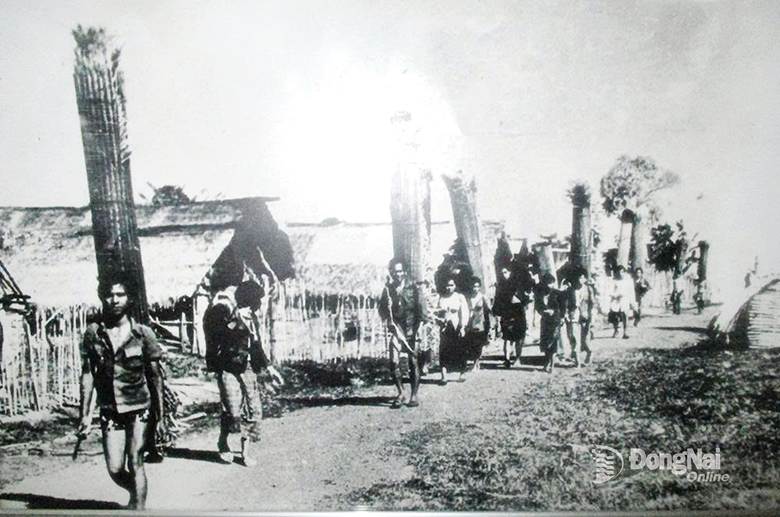 |
| Revolutionary struggle movement of Bom Bo people during the resistance war. Photo: document |
Teacher La Van Hung, Dak Nhau Primary School, Dak Nhau Commune shared: Nua Lon Base is now just a forest bordering the green cashew and rubber gardens of the people, the old traces have faded over time. However, the name and the heroic feats of the army and people here are always remembered by the next generations. "Although the base no longer has clear traces, I always hope that students will know and be proud of their national history. In particular, students of the Stieng ethnic group need to engrave in their minds typical heroic and loyal examples such as: Dieu Xien, Dieu K'Rú (A), Dieu Doan, Ho Thanh Van... It is the sacrifice and dedication that has contributed to the glorious tradition of the homeland" - teacher La Van Hung said.
New look on the heroic land
The road to Nua Lon Base today has been paved with smooth asphalt, winding through the green hills of cashew and rubber. Dak Nhau Commune currently has 13 villages, 26 ethnic groups, of which ethnic minorities account for about 51.7%. The natural area of the commune is more than 182km2, the population is more than 23 thousand people. In terms of economy , agriculture still holds the dominant position in the locality. The Resolution of the 1st Congress of Dak Nhau Commune Party Committee, term 2025-2030 sets 2 goals: the rate of total state budget revenue growth strives to reach an average of 10% annually; the rate of total product value growth in the area strives to reach an average of 10% annually.
Dak Nhau is promoting the conversion of crop structure, prioritizing the expansion of high-value crops such as fruit trees, rubber, coffee; developing industrial livestock farms. Agricultural extension, veterinary, and plant protection work are being implemented effectively, contributing to improving productivity and quality of agricultural products.
With great contributions to the cause of national liberation, the people and armed forces of Dak Nhau commune were honored to be awarded the title of Hero of the People's Armed Forces by the Party and State on December 20, 1994.
Mr. Nguyen Trong Lam, Party Secretary, Chairman of the People's Council of Dak Nhau commune, said: The Party Committee of the commune has specified the development goals in the Draft Document of the 1st Party Congress of the commune, term 2025-2030. Accordingly, it has set out 5 key tasks, 4 breakthrough areas: breakthrough in master planning, management of construction order and development of synchronous and inter-regional traffic infrastructure; breakthrough in comprehensive new rural construction, housing development and ensuring social security; breakthrough in agricultural restructuring, building sustainable value chains and applying high technology; breakthrough in developing high-quality human resources, applying digital transformation and preserving and promoting national cultural identity associated with tourism.
After the merger, the production space was expanded, creating opportunities for Dak Nhau to promote its potential, available space and issue correct and popular decisions. The commune aims to link regions with neighboring localities, focusing on developing green, clean and efficient agriculture, taking agriculture as a pillar, high-quality products as a driving force to improve people's lives. The commune is determined to strive to complete the goal of building an advanced new rural area by 2030, making Dak Nhau a comprehensively developed, rich in identity and livable countryside.
New look on the heroic land
The road to Nua Lon Base today has been paved with smooth asphalt, winding through the green hills of cashew and rubber. Dak Nhau Commune currently has 13 villages, 26 ethnic groups, of which ethnic minorities account for about 51.7%. The natural area of the commune is more than 182km2, the population is more than 23 thousand people. In terms of economy , agriculture still holds the dominant position in the locality. The Resolution of the 1st Congress of Dak Nhau Commune Party Committee, term 2025-2030 sets 2 goals: the rate of total state budget revenue growth strives to reach an average of 10% annually; the rate of total product value growth in the area strives to reach an average of 10% annually.
Dak Nhau is promoting the conversion of crop structure, prioritizing the expansion of high-value crops such as fruit trees, rubber, coffee; developing industrial livestock farms. Agricultural extension, veterinary, and plant protection work are being implemented effectively, contributing to improving productivity and quality of agricultural products.
With great contributions to the cause of national liberation, the people and armed forces of Dak Nhau commune were honored to be awarded the title of Hero of the People's Armed Forces by the Party and State on December 20, 1994.
Mr. Nguyen Trong Lam, Party Secretary, Chairman of the People's Council of Dak Nhau commune, said: The Party Committee of the commune has specified the development goals in the Draft Document of the 1st Party Congress of the commune, term 2025-2030. Accordingly, it has set out 5 key tasks, 4 breakthrough areas: breakthrough in master planning, management of construction order and development of synchronous and inter-regional traffic infrastructure; breakthrough in comprehensive new rural construction, housing development and ensuring social security; breakthrough in agricultural restructuring, building sustainable value chains and applying high technology; breakthrough in developing high-quality human resources, applying digital transformation and preserving and promoting national cultural identity associated with tourism.
After the merger, the production space was expanded, creating opportunities for Dak Nhau to promote its potential, available space and issue correct and popular decisions. The commune aims to link regions with neighboring localities, focusing on developing green, clean and efficient agriculture, taking agriculture as a pillar, high-quality products as a driving force to improve people's lives. The commune is determined to strive to complete the goal of building an advanced new rural area by 2030, making Dak Nhau a comprehensively developed, rich in identity and livable countryside.
Source: https://dongnai.gov.vn/vi/news/van-hoa-dong-nai/ve-dak-nhau-nghe-chuyen-can-cu-nua-lon-57304.html






![[Photo] General Secretary To Lam and National Assembly Chairman Tran Thanh Man attend the 80th Anniversary of the Traditional Day of the Vietnamese Inspection Sector](https://vphoto.vietnam.vn/thumb/1200x675/vietnam/resource/IMAGE/2025/11/17/1763356362984_a2-bnd-7940-3561-jpg.webp)

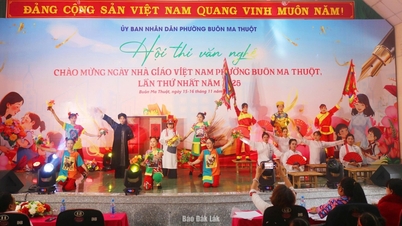


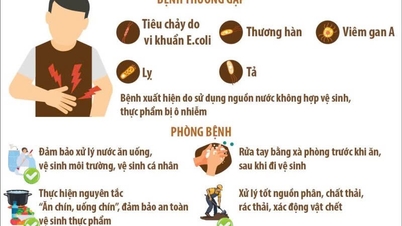

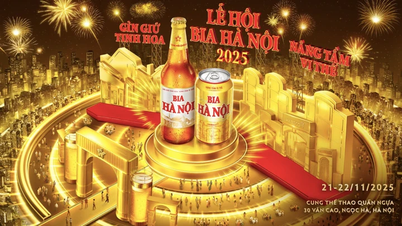

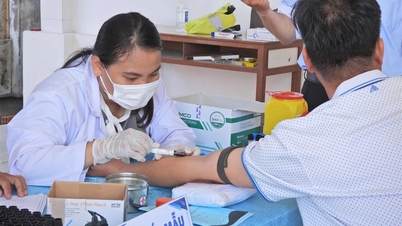
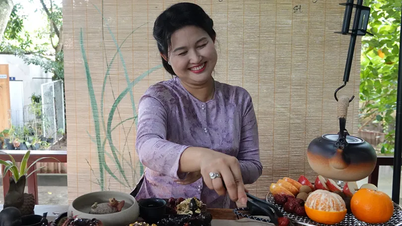







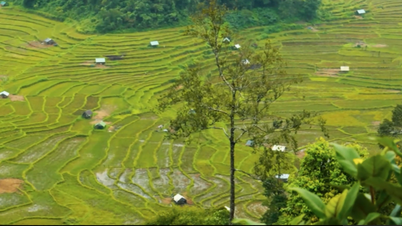



















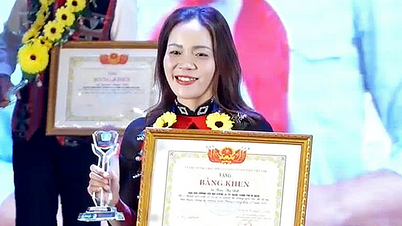




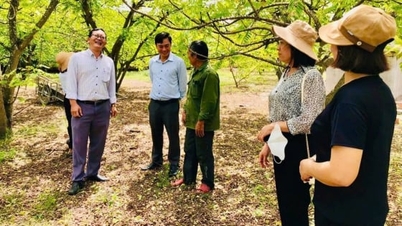




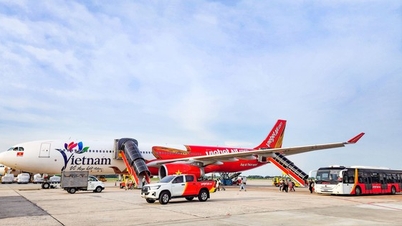

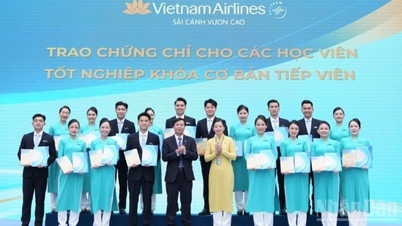







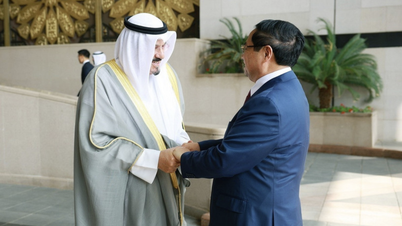
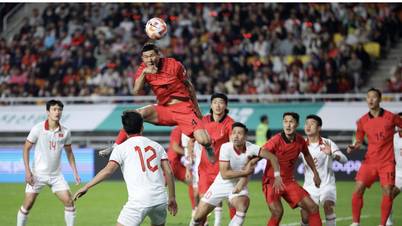


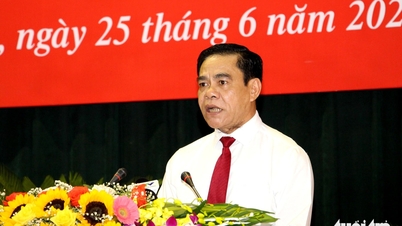
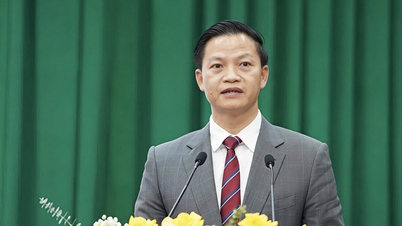








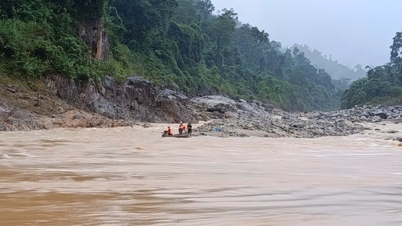




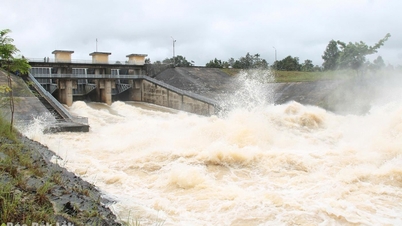















Comment (0)